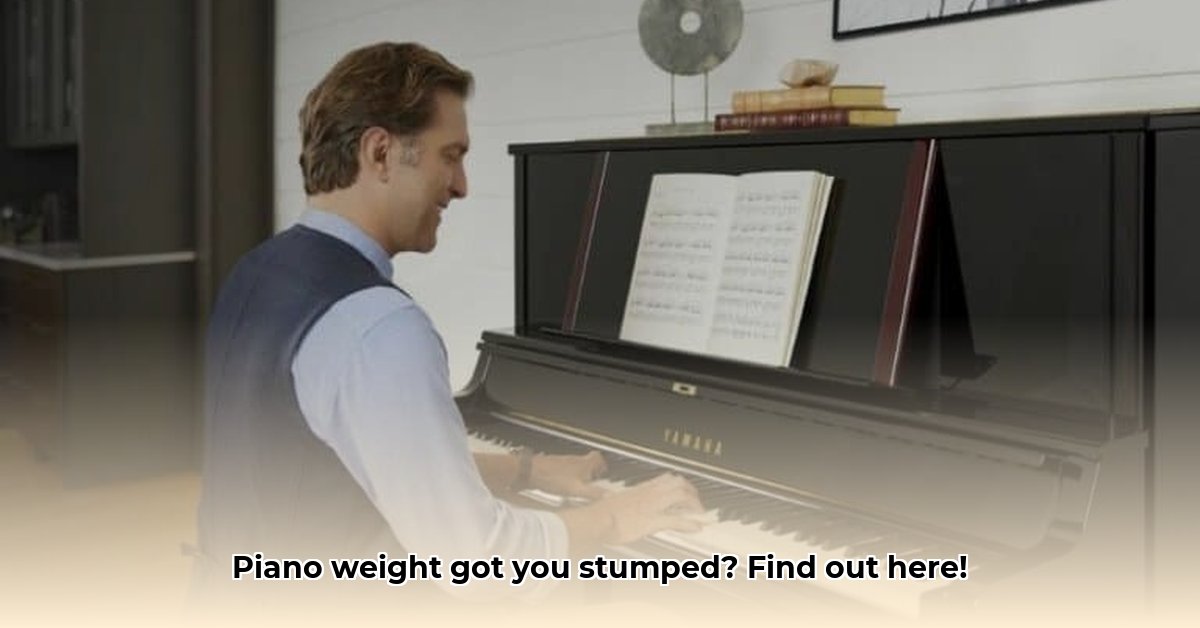Knowing a piano’s weight is crucial for moving, buying, or even simply placing it in your home. This guide provides a comprehensive overview of piano weights by type and size, offering both a quick reference and detailed explanations.
Quick Guide to Piano Weights
For those in a hurry, this table provides estimated weight ranges. Remember, these are averages, and the exact weight can vary. Always consult the manufacturer’s specifications for precise figures.
| Piano Type | Size/Subtype | Weight Range (lbs) | Weight Range (kg) |
|---|---|---|---|
| Vertical/Upright | Spinet | 300-400 | 136-181 |
| Console | 400-500 | 181-227 | |
| Studio | 450-550 | 204-249 | |
| Full Upright | 500-800 | 227-363 | |
| Grand | Petite Baby Grand | 450-550 | 204-249 |
| Baby Grand | 550-650 | 249-295 | |
| Medium Grand | 650-750 | 295-340 | |
| Living Room Grand | 700-800 | 318-363 | |
| Professional Grand | 750-850 | 340-386 | |
| Parlor/Recital Grand | 800-900 | 363-408 | |
| Semi-Concert/Ballroom | 850-950 | 386-431 | |
| Concert Grand | 900-1200+ | 408-544+ | |
| Digital | Portable | 20-50 | 9-23 |
| Console/Spinet Style | 100-300 | 45-136 | |
| Keyboard | Varies | 5-50 | 2-23 |
Understanding Piano Weight by Type
Upright Pianos
Upright pianos vary significantly in weight, primarily due to their height and construction. Spinets, the smallest, are generally manageable, while full uprights can weigh as much as a small car. This weight difference emphasizes the need to know your piano’s specific type before moving or purchasing. The cast iron plate, or harp, is a significant contributor to the weight of all pianos, including uprights.
Grand Pianos
Grand pianos are the heavyweights of the piano world. Their length, directly related to string length and soundboard size, is a key factor in their overall weight. Longer strings necessitate a stronger frame, hence the increased mass. Even a baby grand can weigh considerably more than an upright.
Digital Pianos and Keyboards
Digital pianos and keyboards offer a lighter alternative, replicating the acoustic piano experience without the substantial internal structure. Their portability makes them ideal for musicians on the move or those with limited space. While some digital pianos are designed as furniture-style consoles and can weigh over 100 pounds, many are significantly lighter, making them a practical choice.
Measuring a Grand Piano
Accurately measuring a grand piano is essential for estimating its weight and planning its transport.
-
Follow the Curve: Measure along the curve from the front of the keyboard to the furthest point on the tail. Avoid measuring straight across.
-
Consult a Chart: Compare your measurement to a piano size chart (like the one above) to determine its category (e.g., baby grand, concert grand) and estimate its weight.
Factors Affecting Piano Weight
The cast iron plate (harp) is the primary contributor to a piano’s weight, often comprising up to 70% of its total mass. This plate withstands the immense tension of the strings, which can exceed 20 tons in a concert grand. The wood type, age, and additional features can subtly affect the overall weight. Older pianos sometimes incorporated denser woods, resulting in a slightly heavier instrument. Historically, pianos initially used wooden frames. However, as musical demands evolved, the need for greater string tension led to the adoption of cast iron in the 19th century, resulting in heavier pianos. Research is ongoing to explore alternative, lighter-weight materials that may influence the weight of future piano designs.
Moving a Piano: Essential Considerations
Moving a piano is a complex undertaking due to its weight, size, and delicate mechanism. Professional piano movers possess the necessary expertise, equipment, and insurance to ensure a safe and damage-free move. Factors influencing moving costs include distance, stairs, and piano type. Obtain quotes from reputable piano movers to compare pricing accurately. Seek recommendations from piano technicians or music stores for trustworthy and experienced movers. Proper piano storage requires a climate-controlled environment, avoiding extreme temperatures and humidity.
Piano Placement: Floor Strength and Environment
Before placing your piano, assess your floor’s load-bearing capacity, especially on upper levels or in older homes. Consult a structural engineer if necessary. They can recommend solutions like reinforcing joists or using weight-distribution platforms. Maintain a stable environment for your piano, ideally with 40-60% humidity and a temperature around 70°F (21°C). Avoid placing the piano near heat or cold sources, direct sunlight, or exterior walls. Smart home technology, such as smart thermostats and humidifiers, helps maintain this ideal environment. Position your piano away from walls to allow for optimal sound projection.
FAQs
- How much does floor reinforcement cost? Costs vary depending on the required work. Consult a structural engineer for a quote.
- How do I find qualified piano movers? Online directories and recommendations from piano technicians or music stores are helpful resources.
- What is the best way to store a piano? A climate-controlled environment is crucial for protecting the wooden components and other materials of the piano.
Conclusion
Understanding piano weight is crucial for various reasons, from moving and placement to purchasing and storage. While this guide provides helpful estimates, always consult the manufacturer’s specifications for precise weight information regarding your specific piano model. Remember, a little planning goes a long way in ensuring the safety and longevity of your instrument.
- Weight Loss Supplements That Work and Those That Dont - October 31, 2025
- Male Eating Disorders Often Missed but Increasingly Prevalent - October 29, 2025
- Males With Anorexia Nervosa Have Distinct Symptoms and Treatment Needs - October 28, 2025










